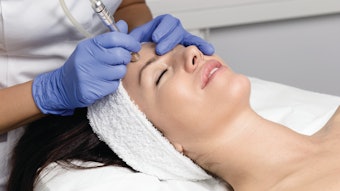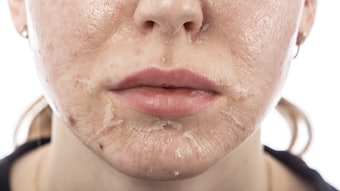
Melasma is a common skin problem that causes brown to gray-brown patches on the face. More likely to affect women and people with darker skin tones, melasma affects more than six million women in the United States.1 Although the exact causes of melasma are unclear, common triggers include sun exposure, pregnancy, birth control pills, and cosmetics.
“Melasma usually appears on the cheeks, forehead, chin, bridge of the nose and above the upper lip, but it can also appear on the forearms or neck,” said Bethanee J. Schlosser, MD, PhD, FAAD, assistant professor of dermatology and director of Women’s Skin Health at Northwestern University, Feinberg School of Medicine in Chicago. “Although it is not harmful, many people dislike the way melasma looks and seek treatment to make it less noticeable.”
If you have melasma, Schlosser recommends the following tips for achieving a more even skin tone.
- Wear sunscreen daily. One of the most common treatments for melasma is sun protection. Since sunlight triggers melasma, it is important to wear sunscreen every day, even on cloudy days and after swimming or sweating. Choose a sunscreen that offers broad-spectrum protection, a Sun Protection Factor (SPF) of 30 or more, and zinc oxide and/or titanium dioxide to physically limit the effects of the sun’s rays on your skin. Apply sunscreen 15 minutes before going outside and reapply at least every two hours.
- Wear a wide-brimmed hat when you’re outside. As a recent study in the journal Nature illustrates, sunscreen alone may not give you the sun protection you need. Whenever possible, seek shade and wear protective clothing in addition to applying sunscreen.
- Choose gentle skin care products. Choose skin care products that don’t sting or burn, as products that irritate the skin may worsen melasma.
- Avoid waxing. Waxing may cause skin inflammation which can worsen melasma, so it’s important to avoid waxing areas of the body affected by the condition. Ask a dermatologist about other types of hair removal that may be right for you.
“Sometimes melasma will fade on its own, particularly if it is triggered by pregnancy or birth controls pills,” said Schlosser. “After a woman has her baby or stops taking the birth control pills, melasma can fade. However, if your melasma does not go away or you want to keep taking birth control pills, see a board-certified dermatologist to discuss available treatments for melasma, such as prescription medications or in-office procedures.”
The “Melasma: Tips to Make It Less Noticeable” video is posted to the American Academy of Dermatology’s (Academy) website and the Academy’s YouTube channel. This video is part of the Dermatology A to Z: Video Series, which offers relatable videos that demonstrate tips people can use to properly care for their skin, hair and nails. A new video in the series posts to the Academy’s website and YouTube channel each month.
1. Pandya, AG, Guevara, IL, Disorders of hyperpigmentation, Dermatologic Clinics 18(1) 91–98 (2000)










